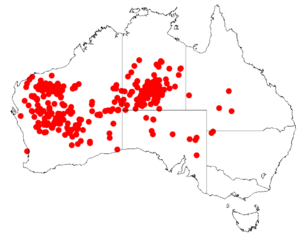Slender mulga facts for kids
Quick facts for kids Slender mulga |
|
|---|---|
| Scientific classification | |
| Genus: |
Acacia
|
| Species: |
aptaneura
|
 |
|
| Where Slender Mulga grows in Australia (data from Australasian Virtual Herbarium) | |
The Acacia aptaneura, also known as the slender mulga, is a type of shrub or small tree. It belongs to the Acacia family, which is a large group of plants. You can find the slender mulga growing naturally in the central and western parts of Australia.
Contents
What Does Slender Mulga Look Like?
This plant usually grows as a shrub or a small tree, reaching a height of about 3 to 10 meters (around 10 to 33 feet). Sometimes, it can even grow taller than 12 meters (about 40 feet)! Many Acacia plants in the "Mulga group" look a bit like conifer trees, which are known for their needle-like leaves.
The branches of the slender mulga have sticky, raised lines and tiny hairs that can be white or reddish. Its flat, straight, or slightly curved leaves, called phyllodes, are green to grey-green. They are quite narrow, about 1.5 to 2.2 millimeters wide, and can be up to 9.5 centimeters (about 3.7 inches) long.
When Does Slender Mulga Bloom?
The slender mulga usually blooms between March and May, and again between June and August. However, you might see its flowers at other times of the year too! It produces pale-yellow, cylinder-shaped flower-heads that grow from the leaf joints.
After the flowers, smooth, hairless seed pods start to form. These pods have a slight orange color when they are new, but turn brown later. They are flat and oblong, about 4 centimeters (1.6 inches) long and 10 millimeters (0.4 inches) wide, with a sticky edge. Inside these pods are brown, oval-shaped seeds, each about 5 millimeters long and 3 millimeters wide, with a long, soft attachment called an aril.
How Was Slender Mulga Named?
Scientists Bruce Maslin and Jordan Reid officially described this plant in 2012. They wrote about it in a scientific paper called A taxonomic revision of Mulga (Acacia aneura and its close relatives: Fabaceae) in Western Australia, which was published in the journal Nuytsia.
The scientific name aptaneura comes from ancient Greek words. The part a- means "without," and pteron means "wing." This refers to the seed pods, which do not have wings. The word neuron means "nerve," and this part of the name points to the fact that the plant's leaves (phyllodes) do not have clear nerves.
Where Does Slender Mulga Grow?
The slender mulga is found in the dry, inland areas of central and western Australia. You can see it in Western Australia, South Australia, the Northern Territory, and even in the outback regions of New South Wales and Queensland.
In Western Australia, it grows in areas like the Pilbara, Mid West, and Goldfields-Esperance regions. It can live in many different places, such as:
- Stony or gravelly red-brown sandy loam soils.
- Clay-loam or clay soils, often over a hard layer of rock or soil.
- Alluvial flats, which are flat areas formed by flowing water.
- Wet areas on slopes and the tops of rocky hills.
In South Australia, it is found in the northern parts, including the North Western, Lake Eyre, and Gairdner-Torrens herbarium regions.

